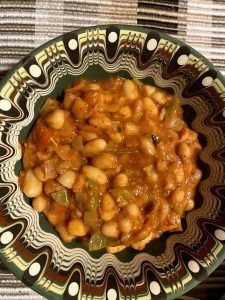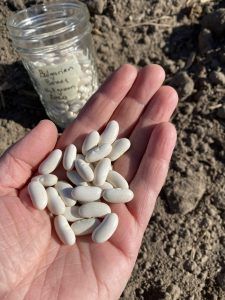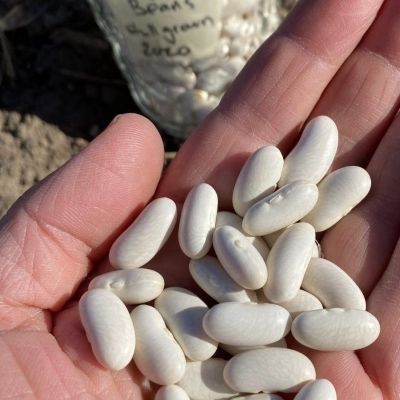Seeds for, and from, ecological farms
By Rebecca Ivanoff
Seed is essential to the fabric of ecological agriculture and is embedded in the work we as a community of ecological growers are doing to create a better world. When thinking about why local, ecological, regionally-adapted seed matters, we must grapple with both systemic influences on seed, as well as the immensely personal relationships that are created when working with seed.
As farmers transition towards more climate-resilient ecological agriculture, we are going to need seeds that thrive in these conditions. Seeds have the amazing ability to adapt to changes in the environment through seed saving, selection, and other classical plant-breeding techniques. Growing organic and adapted seeds in our fields and gardens — seeds that have come from plants that have grown and thrived in similar soils and ecosystems — means that they will have the genetic information they need to flourish. This adaptation is key for a crop’s surviva l— mitigating risks for the growers and the communities they feed, helping reduce the need for synthetic, fossil-fuel-derived inputs, and ultimately, making our farming systems more resilient.
In contrast, crops grown from seeds bred or adapted in farming systems that use fertilizer and other synthetic inputs are not as well-suited for ecological and organic management. Moreover, by purchasing seeds bred or grown using synthetic inputs, we are supporting the very farming systems that we are trying to build alternatives to within the ecological farming movement.
In preliminary trials, wheat populations that were selected by ecological growers in the Prairies as part of a participatory plant breeding (PPB) program with the University of Manitoba and The Bauta Family Initiative on Canadian Seed Security showed that farmer selections under organic conditions can outperform conventional varieties and often have traits desired by organic growers such as longer straw length, which is desirable due to straw’s many uses on organic farms.

PPB wheat trials in Brandon, Manitoba, 2021. (Photo by Tierra Stokes)
If these results are possible with PPB wheat, what might the possibilities be for other crops? Could farmers breed a watermelon that ripens early enough for Northern Ontario market farmers? What about high performing organic dry beans for Ontario’s climate? There is no shortage of crop priorities for farmer-breeders to consider.
In order to produce local, regionally adapted crops, we need to have genetic diversity to select from. Globally, however, we’ve lost 75% of agricultural biodiversity in the last century. As growers, we may find that varieties we have loved and relied on may no longer be available for purchase or are not available organically.
As seed companies consolidate, they often drop varieties that do well in specific areas, in order to focus on those that perform uniformly across the country. Of course, farmers must have access to the seeds that meet their needs, and this can include hybrid seeds, especially in the organic sector where options are more limited. However, when an entire industry shifts its focus and resources away from open-pollinated varieties in favour of hybrids, there is an impact on biodiversity overall.
One of the consequences of consolidation in the seed industry, and the increased reliance on hybrids, is both a decrease in the number of open-pollinated varieties available, but also a loss of quality among these open-pollinated varieties. This often puts farmers in a hard place, where local organic growers feel they can’t take a chance on poorly stewarded open-pollinated varieties. They may then turn to better cared-for hybrids that perform reliably, but do not offer the same opportunities for seed saving, regional adaptation, and seed sovereignty.
Thankfully, regional, organic seed companies and on-farm breeders are actively improving open-pollinated crops. By supporting regional seed companies, we can support the continued existence of varieties, help maintain biodiversity, and grow crops from seed that hasn’t travelled great distances. These varieties will be more likely to thrive in our gardens, thus producing delicious tasting food.
Seed Relationships
When we plant a seed, we are connected to a multitude of relationships. We are connected to the soil, the plant that grows, and to the abundance of the crop. And we also build relationships with ancestors, with culture, and with future generations.
I have a distant memory of my Dedo, whose pockets were always full of seeds (for the birds), showing me the seeds in the heads of mature sunflowers, and I remember my mum telling me not to put my fingers in my mouth after planting the peas with the bright pink powder on them. But I don’t have many other childhood memories related to seed. When I started learning about seed saving much later in life, I grew seeds from my mentor Johann and from Seeds of Diversity. As I began talking to other seedkeepers, I became curious about what seeds my family had saved in the past. What varieties of peppers were grown? What type of peas? What shape of white bean was needed for making the bean dish we always ate called bop (боб)? These questions led me to have conversations with various family members where I heard stories about culturally meaningful foods and plants that were specific to my family.

Bop made with white beans from Debelez. (photo by Rebecca Ivanoff)
Upon my request, my parents brought me back seed from family friends in Bulgaria, and my dad’s cousin in Switzerland helped me translate their names. One bean only came with the description “white bean” and that it was from Debelez, Bulgaria. My Turkish-American friend, Mehmet (whose grandfather and my grandfather were born in the same area of Bulgaria), shared that this bean looked like the variety Horoz, a common variety in western Turkey where many descendants of Bulgarian Turks live and is used to make a dish called kuru fasulye (which looks similar to my bop!). This year, after a few years of growing and selecting the best of that variety, I’m growing a big patch of this bean so that I can share the harvest with Mehmet, as well as cook bean stew for friends and family. I find myself taking special care of these plants because of the relationships they represent — to the seed community I am a part of, my own heritage, and to the land where I now grow these seeds. As my colleague Solvieg Hanson, coordinator of the Canadian Organic Vegetable Improvement (CANOVI) program, said to me, “It’s this element of healing, cultural and social connection, and creativity that makes regionally-produced seed sing.”

Rebecca planting Bulgarian White Beans in her garden, Spring 2022. (photo by Rebecca Ivanoff)
Though many of us have lost some of our relationships with seed — our seed keeping knowledge, and many of the varieties our families once stewarded — relearning these practices is a form of cultural preservation and connection. Mohawk seedkeeper Rowen White writes, “people are remembering our responsibility to care for the seeds…Since the dawning of agriculture, people have been passing seeds down from generation to generation… All seeds that grace our fields and gardens and tables all descend from the collective efforts of countless ancestors, carefully selecting the right seeds that meet the needs of the family, the village, the land, the watershed, the bioregion.”
EFAO and The Bauta Initiative partner with organic and ecological seed producers and farmers to advance agricultural biodiversity, and increase the quantity, quality, and diversity of locally grown, regionally adapted seed. We believe in seed systems that have many decision makers at the table, including seed growers/savers, plant breeders, farmers, consumers, chefs, Indigenous seedkeepers, and you who are reading this article. A diversity of hands working with seed are needed so that crop production matches the cultural foodways of our region’s diverse populations. Regionally adapted seed is an integral way to maintain the cultural, ancestral, and social connections that matter so much.
Folks often ask me how they’ll know if the seed they purchase is organic, open-pollinated, or regionally-adapted. I encourage them to ask: ask your local seed company where they source their seeds, ask where and by whom they are grown, and ask what they are selected for. The seed companies who are doing this important work will be delighted to answer these questions.
When working with seeds you can be of service to the world – to humans, plants, soil – with roots into the past and reaching out, like bean tendrils, into the future.
Rebecca Ivanoff is EFAO’s Seed Program Manager. Rebecca supports farmers to learn about regional seed production, and to implement participatory variety trials and plant breeding projects as part of The Bauta Family Initiative on Canadian Seed Security and EFAO’s Farmer-Led Research Program.
| Demonstration Gardens: Farmers and seed stewards across Canada create and adapt an incredible diversity of plants through plant breeding and selection. This work is at the heart of seed security and emerging regional seed systems across the country, and it is vital to sustain climate resilient agro-ecological agriculture. In 2022 and 2023, we will be showcasing this work as well as trialling regional varieties at demonstration sites across Canada. These sites are places where you can see, touch, taste, and smell the beauty, deliciousness, and resilience of regionally- bred and adapted varieties. Each site will host training workshops, tours, and tasting events. This project is funded in part by the Government of Canada through Agriculture and Agri-Food Canada’s Canadian Agricultural Strategic Priorities Program (CASPP), a $50.3 million, five-year investment to help the agricultural sector adapt and remain competitive
Ontario’s regional seed Demo Gardens are sites for exploring and showcasing 80 different vegetable varieties best suited for regional seed production, growing seed for conservation in partnership with Seeds of Diversity, and trialling okra, red pepper varieties, and carrot varieties in collaboration with farmers across the province. For more information about these sites, visit: http://www.seedsecurity.ca/engage or https://efao.ca/seed-security/ |

